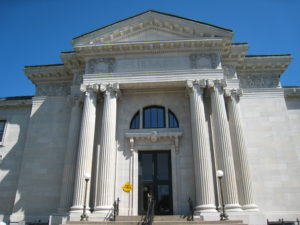
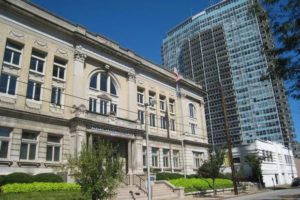
The neighborhood between the Central Business District, Limerick and Old Louisville dubbed SoBro or the South of Broadway neighborhood has always connected important business and residential areas in historic portions of the downtown corridor. Historically, the neighborhood mixed residential, manufacturing and commercial uses. Now, the city has another idea.
The city designated SoBro as a planned development district, in the hopes to revitalize the area and promote Louisville as a place for creativity, diversity and investment.
That’s a good idea.
During the urban flight of the fifties and sixties many neighborhoods like SoBro were abandoned for the suburbs. Neighborhood land parcels were converted into blacktop lots. In fact, at one point more than 60 percent of SoBro was a parking lot.
SoBro’s charm abounds. Founded after the civil war, SoBro was, and remains, home to the mid-century landmark, 800 Tower City Club Apartments, which was once Louisville’s tallest building. It is also home to several educational institutions such as Simmons College, Jefferson Community & Technical College, Spalding University, and Presentation Academy, not to mention the main branch of the Louisville Free Public Library, Center for Women & Families and Christian Care Communities.
Visiting SoBro today, the changes are noticeable. Murals enhance properties. Buildings are undergoing construction. New landscaping and green spaces adorn the neighborhood. For example, Spalding University expanded and plans to break ground this fall on a $5.5 million athletic fields project, which will include soccer fields, a softball field, locker rooms and concession stands. Architecture firm Luckett & Farley purchased adjacent properties to its SoBro-based headquarters and is collaborating with neighborhood partners to serve the city’s larger mission of adding life back into the area.
Louisville Distilled took a survey of the neighborhood, met with and spoke with some newer SoBro residents. The excitement about what is possible was evident in each conversation.
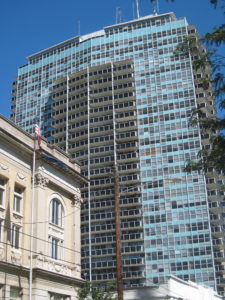
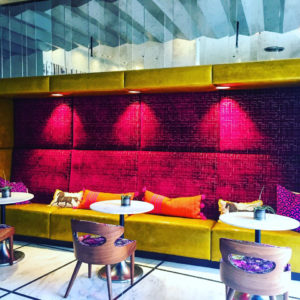
The 800 Tower City Club Apartments
The 800 Tower City Club Apartments was previously named and is still colloquially referred to as the “800 Building.” It was completed in 1963 and was the tallest building in Louisville until 1971. A couple of years ago, Jonathan Holtzman bought the building and renamed it the “800 Tower City Club Apartments.”
The revamp of the building has involved exterior updates including a modern entryway, new landscaping, lighting and work to replenish the signature blue color of the building. The building was also outfitted by ATT with U-verse technology and work was completed using Class-G certified green construction practices.
“We took our responsibility very seriously for transforming this iconic building into something special for the Louisville community,” says Holtzman. “This is a great building with million-dollar views. Our investment has had a positive impact on South Broadway and downtown Louisville.”
The building has 286 units with a mix of studio, convertible one and two bedroom apartments, and penthouses. The building will house an Italian restaurant, Bar Vetti, which will be operated by local chef, Ryan Rogers who currently owns Feast BBQ and Royals Hot Chicken in NuLu.
“Our neighbors in Old Louisville are just as excited as we are to see this renovation completed,” Holtzman shares. “We’re are extremely supportive of one another and excited for all the changes that are planned and currently underway.”

Luckett & Farley
Established in 1853, architecture firm Luckett & Farley has more than 160+ years under its belt. It is the firm that designed the Twin Spires at Churchill Downs. The original drawings now line its halls. The company is also 100 percent employee owned.
Located in SoBro since the late 1990s, Luckett & Farley recently elected a new company President, former Vice President and architect Aric Andrew. Andrew succeeds Ed Jerdonek who sat at the helm of the company from 2005 until the end of 2016. The new leadership provides Luckett & Farley continuity and the opportunity for the firm to expand its services. The bulk of their services fall in the architecture, engineering and interior design areas but the recently added development services are quickly growing into an important piece of the company’s offerings.
With expanded services, Luckett & Farley is expanding their square footage. With the purchase of the parking lot and adjacent two-story building the company hopes to move the majority of their offices and create a mixed-use venue with their current space. The revamp of the space will allow for a more diverse workforce and possibly add amenities to the neighborhood.
“We’ve grown significantly. I’d love to put a restaurant in here, something that would really complement the neighborhood,” says Andrew.
The current office building has common areas where staff can collaborate and work together as well as separate more traditional desk areas that allow for employees who enjoy structure.
Luckett & Farley has forged strong collaborative relationships with their neighbors, too.
Presentation Academy approached Luckett & Farley about upgrades the school desperately needs. “We’re going to be working with them to develop their campus. We’re partnering with them in terms of expanding that campus, parking and ball fields,” says Andrew.
In addition, the firm has purchased the JVC building where Jefferson Community and Technical College houses their administrative offices. The plans to renovate this building include a partnership with the school to create updated offices, student living and a new campus bookstore. The renovation will also include space for other organizations to rent space in the building.
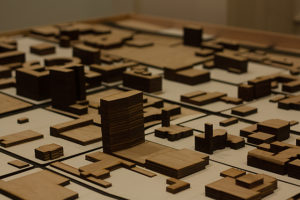

Maker’s Crucible
On the lower level of Luckett & Farley’s 741 S. Third St. location is art gallery/art workspace called the Maker’s Crucible. Curated and managed by glass artist and freelance art appraiser Naomi Stuecker, the gallery was the result of a partnership between local artists, Luckett & Farley engineers and developers.
It is intended to be a space that showcases challenging art while also offering wearable, and decorative pieces. Throughout Luckett & Farley there is a generous collection of Stephen Rolfe Powell glass including pieces that are radically different from the plump vases for which he’s well known.
“I have a degree from Centre College, studied under him and have represented him for years,” says Stuecker.
Stuecker envisions the space becoming a multi-use venue. Artist and art educator John Begley keeps a space in Maker’s Crucible while he and Stuecker work on a full appraisal of his artworks and writings.
“I’m going into appraisal, and John has an art collection and a writing collection that we need to appraise. I have clients saying could you evaluate our art collection
I love art history; but I need hands on,” says Stuecker.
Maker’s Crucible is open daily.
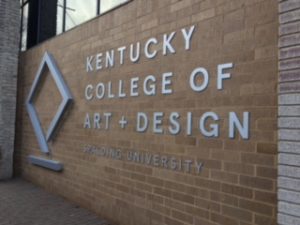

Kentucky College of Art and Design
Louisville native and educator Churchill Davenport had a dream that he could bring a focused art academy to his hometown. Having spent years teaching at the Maryland Institute College of Art and Pratt Institute in New York, he was ready to return to his roots. He brought the idea to a group of artists, educators, and interested parties. Initially the concept operated as a series of artist lectures, workshops and art appreciation classes many of which were hosted by 21C Museum Hotel. 
In 2010, the fledgling academy got a permanent home at Spalding University in SoBro. The student body grew from nine regular students to more than 130. With its move to Spalding the Kentucky School of Art became the Kentucky College of Art and design (KyCAD).
“We began leasing space in Spalding’s old science building on the northwest corner of Third Street and Breckinridge,” says Assistant Professor and one of KyCAD’s founding members Skylar Smith.
In addition to her work at KyCAD, Smith is a working artist. She was one of the original instructors with the school and enthusiastically shares the work the school is producing. Since KyCAD moved into the neighborhood, Smith says the changes are noticeable.
“The radio station ARTxFM–a big supporter of the arts–moved in last year to Fifth and Breckinridge, adding to the creative vibe,” she says. “Fourth Street has seen many more developments with the Hilton and 8UP, new restaurants, and independent shops and galleries like Craft(s) Gallery and Mercantile and Gifthorse.”
KyCAD hopes to grow not only its student body but also to develop its community. “KyCAD seeks to harness the power of art and design to break down barriers and advance the individual, community and world—both socially and economically,” says Smith.
Eventually the school hopes to become an independent art school with their own accreditation. They are on the path to do so. Moira Scott Payne became the school’s first dean this past June and became president earlier this month.
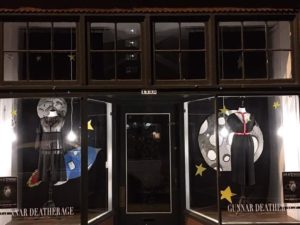
Gunnar Deatherage Studio Showroom
Many people know fashion designer Gunnar Deatherage from his bold personality on television’s Project Runway. Deatherage appeared on the show twice. Back home in Louisville, he’s cultivated a life of hard work and creativity. He is a full-time hairstylist and works as a creative director with many local publications.
In December, Deatherage opened his own studio and showroom in the SoBro neighborhood. Located at 1155 South Second Street, Deatherage envisions the space to be an event and collaboration hub for creatives in the neighborhood.
“My goals, personally, are to keep bringing up-and-coming artists into my space — hosting events with them. It only makes sense with being so close to UofL and them having such a great art program, and Spalding having an amazing program,” says Deatherage.
Outside of events, his space is open by appointment only. “It’s mainly just a workspace for me however I curate it really well. I chose it because it has a lot of walls, a lot of history,” he says.
SoBro is more than the next big thing. Its roots are big and strong. It is residential and commercial, yet serves a large academic community. The potential is rich for making SoBro a place to plant even more roots and that is what most residents and businesses intend when they choose to call SoBro home.

